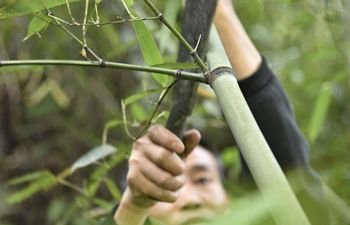NAIROBI, Nov. 9 (Xinhua) -- Ongoing heavy rains in Kenya have disrupted maize drying across the country, complicating the plight of hundreds of farmers growing the staple.
Farmers in the East African nation, the majority of whom are currently harvesting or have just finished harvesting, solely depend on the sun for maize drying for lack of better facilities like electric dryers.
The farmers shell and spread their maize in the sun for up to three weeks every day for it to dry and have the acceptable moisture content at about 13 percent.
But with the heavy rains that have been pounding Kenya for the last two weeks, drying the grain under the sun is impossible.
This is because some places have flooded while others are getting rains each day, which sometimes last the entire day. The Meteorological Department had forecast the downpour would continue for the better part of this month.
"I harvested my maize last week from three acres and stocked it on the farm, but for the last one week, I have not been able to remove all the produce because of the rains," Samson Andaye, a farmer in Bungoma in western Kenya, said on Thursday.
Andaye termed this year as the worst for maize farmers who have grappled with many challenges since the season started.
"If it is not unreliable rains, it is the armyworms or head smut disease and now the rains which are adding more misery to farmers," said Andaye, who spent a fortune fighting armyworms on his farm.
However, his efforts of triumphing against the deadly pest may be washed away by the rains since he is at risk of losing a chunk of his harvest due to the deluge.
"My prayer is that the rains reduce in intensity so that once I remove the cobs from the farm, I would be able to dry the maize comfortably or I can keep in the store instead of them remaining in the field," he said.
Patrick Kipyegon, a farmer in Bomet County is facing a similar crisis, however, unlike Andaye, he has already shelled his maize.
"I shelled three weeks ago and I was in the process of drying the produce but now the rains came, making it difficult for farmers. You spread the grains in the sun then after an hour or two it starts to rain. You cannot achieve much with such conditions," he said.
In Kenya, according to the Ministry of Agriculture, post-harvest losses range from 10-20 percent of the total volumes.
Among the contributing factors are farmers' habit of cutting maize and leaving it in the field for too long, exposing the crop to fungal rots.
And with the ongoing rains, this becomes a major problem for farmers, leading to development of poisonous aflatoxin in the grain.
Bernard Moina, an agricultural extension officer in Kitale, one of Kenya's breadbaskets, identified other causes of post-harvest losses among smallholder farmers as inadequate access to better processing facilities, premature or late harvesting and lack of access to good quality packaging materials and storage materials.
High post-harvest losses reduce the amount of accessible maize in the grain market escalating the price, which is currently standing at 30 U.S. dollars per 90 kg bag.
Kenya's annual demand for maize is about 50 million bags, but the country is expected to harvest this season 32 million 90kg bags down from over 40 million mainly due to poor rains and armyworms.
According to Tegemeo Institute, an agriculture think-tank, some 29 million bags of maize would come from the long rains harvest and 3 million from the short rains.
With post-harvest losses set to rise due to the rains, Kenya would in the coming months rely on imports from Uganda, Tanzania and Malawi.
However, there is hope for struggling smallholder farmers as the government on Wednesday offered to dry the maize for them for free at its silos when they deliver it to them.
Agriculture Cabinet Secretary Willy Bett on Wednesday said the government would dry the maize delivered to its facilities for the strategic grains reserve storage.
"Weather conditions are very bad, we will dry maize for farmers at no cost. We have set aside 70 million dollars for the exercise," he said.
However, not all farmers would benefit from the move as in some maize growing areas, the cereals board offices are unavailable.
Farmers who would benefit from the move are expected to save up to 1.4 dollars per 90 kg bag and escape post-harvest losses.

















